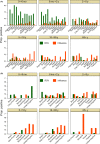Clinical characteristics, predictors, and performance of case definition-Interim results from the WHO global respiratory syncytial virus surveillance pilot
- PMID: 31670892
- PMCID: PMC7578293
- DOI: 10.1111/irv.12688
Clinical characteristics, predictors, and performance of case definition-Interim results from the WHO global respiratory syncytial virus surveillance pilot
Abstract
Background: The lack of a uniform surveillance case definition poses a challenge to characterize the epidemiology, clinical features, and disease burden of the respiratory syncytial virus (RSV). Global standards for RSV surveillance will inform immunization policy when RSV vaccines become available.
Methods: The WHO RSV surveillance pilot leverages the capacities of the Global Influenza Surveillance and Response System (GISRS). Hospitalized and non-hospitalized medically attended patients of any age were tested for RSV using standardized molecular diagnostics throughout the year in fourteen countries. An extended severe acute respiratory infection (extended SARI) or an acute respiratory infection (ARI) case definition was used that did not require fever as a criterion.
Results: Amongst 21 221 patients tested for RSV between January 2017 and September 2018, 15 428 (73%) were hospital admissions. Amongst hospitalized RSV-positive patients, 50% were aged <6 months and 88% <2 years. The percentage of patients testing positive for RSV was 37% in children <6 months and 25% in those aged 6 months to 2 years. Patients with fever were less likely to be RSV positive compared to those without fever (OR 0.74; 95% CI: 0.63-0.86). For infants <6 months, 29% of RSV ARI cases did not have fever.
Conclusion: Requiring fever in a case definition for RSV lowers the sensitivity to detect cases in young children. Countries should consider ways to leverage the GISRS platform to implement RSV surveillance with an augmented case definition amongst the young pediatric population.
Keywords: case definition; respiratory syncytial virus; surveillance.
© 2020 The Authors. Influenza and Other Respiratory Viruses Published by John Wiley & Sons Ltd.
Figures



References
-
- PATH The global respiratory syncytial virus burden ‐ a summary of the latest estimates. 2018.
-
- PATH . RSV vaccine and mAb snapshot. 2018. https://vaccineresources.org/details.php?i=1562. Accessed October 16, 2018.
-
- Falsey AR. Respiratory syncytial virus infection in adults. Semin Respir Crit Care Med. 2007;28(2):171‐181. - PubMed
-
- Falsey AR. Respiratory syncytial virus infection in elderly and high‐risk adults. Exp Lung Res. 2005;31(Suppl 1):77. - PubMed
Publication types
MeSH terms
Grants and funding
LinkOut - more resources
Full Text Sources
Medical

